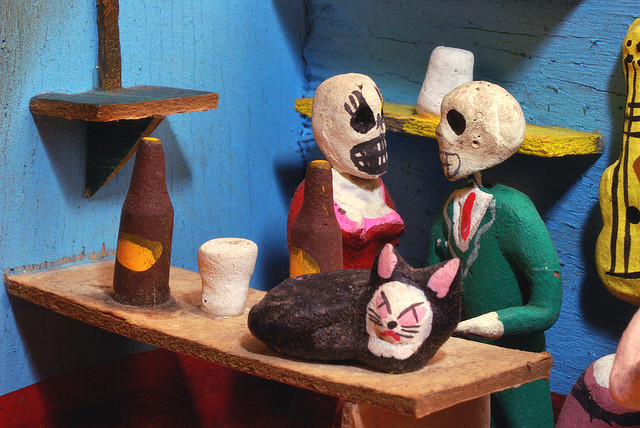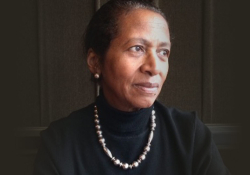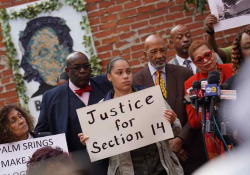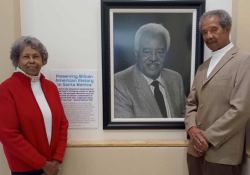Raquel Castro Asks Herself, “Is It True There Is No Humor in Mexican Literature?”

I asked myself these questions in a field outside an apartment community in Dallas, Texas. It was cold. The people walking by looked at me strangely either because I was speaking Spanish or because it’s weird for someone to ask herself questions out loud. What surprised me is that the ducks in the pond also looked at me strangely—as if they didn’t know me!
Q: What is humor to you? How does it function?
A: Humor is a friendly way of turning the established, what is expected to happen, on its ear. Its evil twin is horror, in my opinion: let’s take, for example, an elderly woman who’s walking down the stairs. What we expect as readers or spectators is that she will arrive wherever she’s going without any mishap—that would be the expected; if, however, she trips, rolls down the stairs, and breaks her neck, we have horror. If she rolls down, and nothing serious happens to her, we have humor: it’s funny because no one expects a venerable elderly woman to do somersaults down the stairs and because nothing irreparable happens to her. I think humor requires those two elements: the unexpected and the innocuous, to which laughter becomes a response of confusion—but an enjoyable confusion, unlike the cries that we hold back (or let out shamelessly) when the expected is interrupted by an event that causes injury. At the same time, humor allows us to question everything that we take for granted: the line that separates human rituals from the absurd is so thin, that almost any daily situation lends itself to a comic scene.
Q: Outside of Mexico, the tradition of the Day of the Dead is probably the most common reference to Mexican humor. Is the commonly held impression about the obsession of death as a basis for that humor true? Is all Mexican humor like that?
A: It’s true that there’s a lot of humor related to death. I think it’s a way of removing the terrifying from a stressful situation (the most stressful of all, probably): by being able to laugh at it, we strip it of its ability to hurt us. It’s a little bit like what happens in black humor. In some way, we think, If I can laugh at that, it must not be too serious. And so we’re able to find the funny side of everything: earthquakes, drug trafficking, murders, absence. Of course, the effect is different than that of “white” (i.e., clean) humor because, deep inside, even if we laugh, we know that it does hurt us, what happens does affect us. In any event, I think that kind of humor is the most well known but not the most abundant. It stands out simply because it seems exotic.
Another frequent kind of humor in Mexico is a sexual humor based on complex wordplay. It’s not like Cary Grant, who looks longingly at a girl as she tells him to decide if he’ll have a breast or a thigh—not at all. These are very, very complex structures that almost always appeal to machismo, manhood itself, and the homosexuality of the interlocutor. No matter how clever it is, I don’t like this kind of humor because it reinforces cultural patterns that seem horrendous to me: homophobia, the degradation of women to mere sexual objects, and, in summary, the superiority of heterosexual men that can and should be imposed by force.
Q: Other people maintain that there is no humor in Mexican literature. Is that true? Why do they have that impression?
A: White humor, black humor, blue or piquant humor are rarely seen in what’s considered “serious literature” in Mexico. Like aristocrats who consider it in poor taste to be seen smiling or yawning, Mexican writers hate it when any sentiment comes through, so they write from an abominable coldness and solemnity. They’re like word processors with feet. As such, those books at most have the equivalent of a slightly wry smile, a cynical and slightly boring humor. I think it has to do with the fact that their authors take themselves too seriously and consider inelegant anything that might fit within a subgenre (without realizing that local-color realism is also a subgenre, in spite of the fact that’s what most dominates our literary tradition). It happens in narrative as well as poetry and in essay: the Mexican author suffers from that boring solemnity which could be expressed, “I know everything so nothing surprises me so I’m not frightened by anything and I don’t laugh at anything.” And the little bit of humor that manages to filter out does so through that contempt. Sure, if humor were truly summarized by “I’m laughing with you, not at you,” the humor of those authors could be summed up with “I’m laughing at you and everyone else, you poor mortals who don’t deserve me.” Fortunately, although they’re legion, they’re not everyone. There are many authors who have dared to shed the armor and give us funny works, including some authors who write what is considered “high literature.” In doing so, they become a headache for those critics who defend solemnity and must find a way to include them in the canon without opening the door of the canon to humor.
Q: What about those exceptional authors? Who are they? What do they write about?
A: In my opinion, one of the most important is Jorge Ibargüengoitia. He is one of those from “high literature” who writes in a humorous style. His chronicles, essays, novels are so witty and funny that everyone should read them; what’s more, they also faithfully depict a given period and a social structure. He also has a few parodic historical novels, something unthinkable in a country in which a joke about a national hero can get a comedian kicked off television or in which a mambo version of the national anthem could get a foreign musician expelled from the country. Another (now deceased) author who explored humor very much in the same way as the Israeli Ephraim Kishon or the American Woody Allen is Marco Aurelio Almazán (1922–91). His mistake was publishing too much, such that his work is comprised of a few brilliant books and a lot of not-so-brilliant ones. Another deceased author: Jorge Mejía Prieto, who, in a single book of stories, achieved wonders in the field of black humor. Unfortunately, Almazán and Mejía Prieto are practically forgotten and out of print. Of living authors, in no particular order, I’ll mention José de la Colina, a short-story writer who tends to play with irony and a very sharp parody; Francisco Hinojosa, who employs high doses of black humor (his book Informe negro [Black report], for example, tells the story of detectives in a humorous and frankly brilliant way); Eduardo Huchín and José Israel Carranza, essayists who aren’t afraid to mix the art of Montaigne with belly laughs; Ricardo Guzmán Wolffer and José Luis Zárate, who, each in his own way, combine elements of science fiction with the handicaps of living in a third-world country and the ensuing hilarity; Alberto Chimal, who explores verbal humor and nonsense in many of his stories and who injects another kind of humor, more subtle but always present in his “serious” works; Antonio Malpica, Pablo Mata Olay, and Jaime Alfonso Sandoval, who write for children in a fresh way, filled with funny situations. . . . There are also poets: Eduardo Langagne, for example, is adept at wordplay and juggling in verse. Of course there are more, but proportionally it’s a very low number compared to the entire universe of Mexican writers.
Q: And what about Mexican women writers? Are there any who practice humor?
A: As I was writing the last response I was thinking to myself: “Damn! What about the women?” I’m afraid our women writers are still very busy breaking with the equation “women’s literature = elitist eroticism + kitchen recipes + romance,” and because of that they tend to take themselves a little too seriously, as is usually the case with literature written by discriminated minorities. However, there have been some exceptions for quite some time. Emma Godoy (1918–89)—about whom Wikipedia says, “prominent in her work are the themes of religiosity, eroticism, solitude, and suffering”—has some stories that border on nonsense (my favorite is one about a servant who steals from her employer so much that the latter ends up bankrupt and is hired as a servant by her former employee, which she enjoys very much because she’s able to get even by stealing without remorse). I think it’s important to mention Fulana de Tal (Jane Doe), author of Anecdotario de una vida inútil . . . pero divertida [Book of anecdotes of a useless . . . but very fun life], a hilarious book that is no longer available. The author, a member of an upper-class Mexican family, kept her true identity hidden and published just three books. I think had she not remained anonymous, she would have been the female equivalent of José Agustín. Two other women writers who write with humor come to mind: Ana García Bergua (in La bomba de San José; her Isla de bobos is, on the contrary, a very sad book) and Karen Chacek (her Nina Complot, a children’s book, deliciously mocks the logic of adults from a child’s perspective). I hope that as more women authors begin to find their space within Mexican literature they will also lose their fear of laughing at themselves and at life.
Q: Tell us about your own work. How would you describe your humorous texts?
A: I should begin with a confession: I’ve been a fan of humor since I was a little girl. I’ve always liked making people laugh and laughing myself; so I began to read books full of humor without knowing that they were considered “not very serious” or part of a subgenre that was frowned upon. This is important because it has a lot to do with my own style of writing: my humorous texts—somewhat in the vein of Emma Godoy, whom I mentioned earlier, and much more in that of Ephraim Kishon (I dislike Godoy’s classism, she’s unable to separate herself from her point of view as a woman from the upper middle class, which renders her less likable to me)—are based in an attentive observation of reality. Thereafter I only exaggerate things a little and that’s it. Some errand at school, the cancellation of a debit card, or the attack of door-to-door salesmen can all be the seed of a story in which I try to take the situation as far as possible. I also like wordplay and duels of wit between characters (I know I’m cheating because, in reality, no character can be wittier than her author). My first humorous text, I think, I wrote when I was twelve. The true story was simple: a group of us went to the international Cervantes festival, one of us bought a papaya in a market and was carrying it throughout the entire trip because there wasn’t an opportunity to cut it and eat it during the entire excursion, which was very chaotic. In my story, the papaya became an international performer who only agreed to return to Mexico City out of love for its owner, and whom, obviously, no one attempted to eat. The second, not long after, was a fictional interview with the Ayatollah Khomeini; in school we were allowed to interview someone, and for me it was easier to make the whole thing up—and exaggerate it, of course: after all, if it was made up, why be content with interviewing someone close?—than actually approach someone and ask them questions. Fundamentally, I think my humor is based on the notion that that “truth is stranger than fiction” nonsense is a despicable lie: in my opinion, fiction (1) is part of reality and (2) is the fun part of reality. In other words, why be satisfied with a boring, routine life if there exists in everything that happens to us material to die laughing at?
Q: What are your influences?
A: The main one, as I said, is Ephraim Kishon. I would build a statue to him if there were room in my house (I’ve already visualized it: a scratchable statue so my cats could also enjoy it). Along with him, Marco Aurelio Almazán, Woody Allen, the Spanish writer Elena Fortún, the Argentine Luis María Pescetti, and the humorous musical group, also Argentine, Les Luthiers. Because I am from a generation addicted to TV a scriptwriter I cannot not mention my movie and television influences: Mel Brooks (a bit; too often he’s a fan of pie-in-the-face, the cheap joke—which doesn’t age well—and vulgar humor), again Woody Allen, Monty Python (more on the side of Cleese/Chapman than Idle), and, from Mexican TV, the Loco Valdés, Anabel Ferreira, and the early Eugenio Derbez. I liked Anabel especially because it was unusual for a young, attractive woman to do comedy; she was a bit like Shelley Long, whom I also loved. I like the idea that one can be a woman and be funny at the same time. It works for me, anyway.
December 2013
Translation from the Spanish
By George Henson










